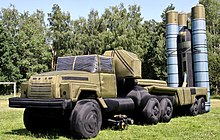
Dummies and decoys are fake military equipment that are intended to deceive the enemy. Dummies and decoys are only one aspect of military deception.
Examples
During World War II, dummy airfields and even towns were used in England to divert German bombers from the real targets. At the Battle of La Ciotat in 1944, American aircraft dropped hundreds of dummy paratroopers (paradummies) just north of La Ciotat, France. The goal of this operation was to divert German troops away from the main landing zones of Operation Dragoon. Additionally, during World War II, Operation Quicksilver was an attempt to mislead the Germans as to the location of the D-Day invasion using dummy military equipment.

A naval example was the British battleship HMS Centurion. Obsolete and disarmed by World War II, she spent two years in the Mediterranean fitted with wooden guns, to make British naval forces in the area seem stronger than they were. Likewise, Fleet tender was the codename for a number of British merchant ships that fitted with dummy structures to resemble warships. During the late Cold War, East German S-200 surface-to-air missile sites employed decommissioned and modified PRV-9 height finding radars as decoys to confuse NATO electronic signals intelligence gathering operations.

In the 1991 Persian Gulf War, BQM-74C Chukar III drones were used as decoys during the initial air attacks into Iraq. One group of drones flew over 500 kilometers (310 miles) at 630 km/h (390 mph), then began to circle Baghdad for up to 20 minutes. Iraqi air defense radars which probed for the drones were engaged by allied strike aircraft firing AGM-88 HARMs (High-speed Anti-Radiation Missiles).
During the Kosovo War, NATO claimed to have destroyed over 100 Serbian tanks and 200 armored personnel carriers using expensive precision-guided munitions, while various estimates place that number much lower. Numerous remains of decoys made of wood and canvas, or from out-of-commission vehicles are instead said to have been found by reporters.
In Russia, a former hot air balloon factory has continued in the 2010s to make dummy tanks, aircraft, missile launch pads, radar stations, and rocket launchers. The inflatable dummies are designed to present a realistic image to enemy radar and thermal imaging.
During the Russian invasion of Ukraine, AFU successfully used wooden dummies of HIMARS in order to divert Russian missile strikes.
An intercontinental ballistic missile may release decoys in addition to one or more warheads.
Military aircraft on SEAD missions may carry decoy missiles such as the ADM-160 MALD which can create aircraft-like return signals on enemy radars.
Russo-Ukrainian War
Ukraine has made widespread usage of decoys as part of the Russo-Ukrainian War. In particular the usage of fake M777 howitzers costing $1000. When the actual weapon costs "several million dollars" to make. Decoys must use steel and wood. This is to match infra-red signature that a real M777 would give off. It also gives a false impression of Ukrainian weaponry. This is in line with fake HIMARS launchers that have been used by Ukraine since August 2022. Russia has also used fake trenches filled with explosives to kill Ukrainian soldiers.
In April 2024, the UK's Ministry of Defence (MoD) reported that Russian occupied Kirovske air base had Su-30 fighter decoys painted on its hardstands and that at least a dozen more Russian air bases had painted similar decoys. The MoD believed the decoys were a reaction to Ukrainian attacks following the Russian invasion of Ukraine.
See also
- Dummy round
- Dummy tank
- Military deception
- Paradummy
- Maskirovka
- Q-ship
- Quaker gun
- Rubber duck
- Sonar decoy
- Victor Jones
References
- "Decoys". Archived from the original on 2012-02-06. Retrieved 2012-03-01.
- Popular Science. Bonnier Corporation. February 1946. p. 126.
- "TarIdeal". Friday, 4 January 2019
- Kraus, Peter (2019). Luftverteidigung der DDR: Fla-Ra-Komplex S-200 »Wega« (in German). Motorbuch Verlag. pp. 82–83. ISBN 9783613042124. OCLC 1112139017.
- Grimes, Bill (2014). The History of Big Safari. Archway Publishing. p. 311. ISBN 9781480804562.
- Freedman, Lawrence (2000). "Victims and victors: reflections on the Kosovo War" (PDF). Review of International Studies. 26 (3): 335–358. doi:10.1017/S0260210500003351.
- Nardulli, Bruce R. (1999). Disjointed war : military operations in Kosovo. Rand.
- "Russia inflates its military with blow-up weapons". BBC News. 11 October 2010.
- "Ukraine lures Russian missiles with decoys of U.S. rocket system". Washington Post. 30 August 2022.
- Sinéad Baker (30 August 2022). "Ukraine is using fake rocket launchers made of wood to get Russia to waste its missiles on useless targets, report says". Business Insider. Retrieved 12 September 2023.
- Melissa Bell; Daria Martina Tarasova; Pierre Bairin (11 September 2023). "True to life but without the price tag: The decoy weapons Ukraine wants Russia to destroy". CNN. Retrieved 12 September 2023.
- Ryan Pickrell (22 July 2023). "Russia built fake trenches along the front lines to lure Ukrainian soldiers into deadly explosive traps, researchers found". Business Insider. Retrieved 12 September 2023.
- @DefenceHQ (April 2, 2024). "Latest Defence Intelligence update on the situation in Ukraine – 02 April 2024" (Tweet) – via Twitter.
- Saballa, Joe (2024-04-08). "Russia Painting Fighter Jet Decoys on Airfields Amid Heavy Losses: Intel". thedefensepost.com. Retrieved 2024-11-02.
| Military deception | |
|---|---|
| Techniques | |
| Equipment | |
| Operations | World War II: |
| Texts | The Art of War |